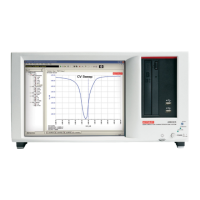3-154 Return to Section Topics 4200-900-01 Rev. K / February 2017
Section 3: Common Device Characterization Tests Model 4200-SCS User’s Manual
Troubleshooting
Check the Error codes for additional information.
No pulse output
If pulses are not being output, please check the following:
1. Ensure proper cabling. The trigger interconnections between the pulse cards must match
the diagram shown in Figure 3-95, Figure 3-96, or Figure 3-97. The TRIGGER OUT from
the pulse card in the lowest numbered slot (right-most slot) must be cabled into TRIGGER
IN of the same card, as well as the TRIGGER IN of all adjacent pulse cards.
2. All size values (PulseVoltagesSize, PrePulseDelaysSize, and so on) must match the value
of NumPulseTerminals. As shown in Figure 3-93, NumPulseTerminals = four and there are
four entries in:
• PulseTerminals
• PulseVoltages
• PrePulseDelays
• TransitionTimes
• PulseWidths
• PostPulseDelays
This rule must be followed for any Program, Erase or Fast-Program-Erase UTM.
3. Ensure that all time-based pulse parameters are not zero. The minimum time interval is 20
ns (20 E-9). This applies to the parameters:
• PrePulseDelays
• TransitionTimes
• PulseWidths
• PostPulseDelays
This rule must be followed for any Program, Erase or Fast-Program-Erase UTM.
4. Ensure that all pulse channel waveforms have the same total time, or period.
a. To check for a single pulse Program or Erase UTM, add up the following for each
channel:
• PrePulseDelays
• TransitionsTimes
• PulseWidths
• PostPulseDelays
All channels should have the same total. If they do not have the same total time, make them
the same by modifying the timing.
b. To check for a double pulse Fast-Program-Erase UTM, add up the following for each
channel:
• PrePulse1Delays
• TransitionsTimesPulse1
• Pulse1Widths
• PostPulse1Delays
• PrePulse2Delays
• TransitionsTimesPulse2
• Pulse2Widths
• PostPulse2Delays
All channels should have the same total. If they do not have the same total time, make them
the same by modifying the timing.

